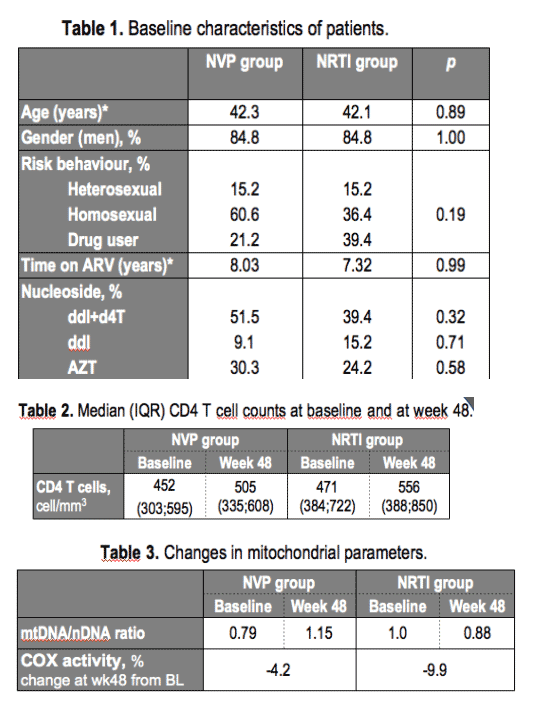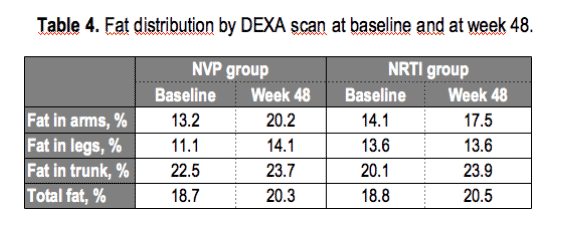 |
 |
 |
| |
Lopinavir-ritonavir plus Nevirapine as a Strategy to Improve Nucleoside-Related Mitochondrial Toxicity in Chronically Treated HIV-Infected Patients: 48 Week Follow-Up of MULTINEKA Study
|
| |
| |
Reported by Jules Levin
IAC Mexico City Aug 3-8, 2008
Negredo E1, Miro O2, Garrabou G2, Moren C2, Cardellach F2, Estany C1, Rodriguez-Santiago B1, Masabeu A3, Force L4, Barrufet P4, Cucurull J5, Domingo P6, Villaverde CA7, Perez-Alvarez N1 and Clotet B1 from MULTINEKA Group
1Lluita contra la SIDA Foundation; Germans Trias i Pujol Hospital; 2Mitochondrial Research Laboratory, Muscle Research Unit, Internal Medicine Department, Hospital Clinic of Barcelona, IDIBAPS, University of Barcelona; 3 Hospital de Palamos, Girona; 4 Hospital de Mataro, Barcelona; 5 Hospital de Figueres, Girona; 6Hospital de Sant Pau, Barcelona; 7 Hospital Sant Joan de Reus, Tarragona, Spain.
AUTHOR CONCLUSIONS
Switching to a nucleoside-sparing regimen using NVP maintained the antiviral efficacy and led to an increase in mtDNA/nDNA ratio and a lower decrease in COX activity, suggesting a reversion of nucleoside-associated mitochondrial toxicity.
Although DEXA did not reveal significant changes, a slight recovery of fat in extremities was seen in patients who interrupted nucleosides. A longer follow-up is probably needed to reveal evident clinical changes.
BACKGROUND and OBJECTIVES
NRTI-induced mitochondrial toxicity has been appointed as a key factor in the induction of lipoatrophy and other nucleoside-related toxicities.
The objective of this study was to evaluate in vivo the effects of NRTI withdrawal on mitochondrial parameters, and those of their replacement by the NNRTI neviparine (NVP) on viral suppression and body fat distribution
DESIGN and METHODS
Study design: The MULTINEKA study was a prospective multicentric study with a randomized, open design, and a follow-up period of 48 weeks. Centers from Catalonia participated in the Mitochondrial Substudy due to the need of availability of fresh samples.
Candidates: Chronically HIV-infected patients under treatment with a HAART regimen >6 months and undetectable plasma viral load (<50/80 copies/mL) >6 months from 13 hospitals all over Spain. Those from Catalonia participated in the Mitochondrial Substudy.
Randomization:
- NRTI group: replace the current PI or NNRTI with LPV/rtv (Kaletra, 3 capsules, BID), and maintain the two NRTIs or,
- NVP group: switch therapy to NVP plus sPV/rtv (Kaletra, 3 capsules, BID). Patients without previous exposure to NVP received a daily dose of 200 mg for the first 2 weeks, increasing to 200 mg of NVP twice daily thereafter.

Assessments:
- Molecular and functional mitochondrial toxicity markers were measured on PBMCs as mitochondrial to nuclear DNA content (mtDNA/nDNA) by real-time PCR and as mitochondrial cytochrome c oxidase (COX) activity using spectrophotometry.
- DEXA scans were used to objectively quantify fat redistribution and changes over time relative to baseline.
All studied parameters were assessed at baseline and weeks 24 and 48.
RESULTS
No virologic failure occurred in any treatment arms.
CD4 cell counts similarly increased in both groups (p>0.05 between groups) (Table 2).
Despite showing a lower baseline mtDNA/nDNA ratio, NVP-treated patients reached higher levels of mtDNA/nDNA at week 48. COX activity diminished in both groups, although the decrease was lower in NVP group (p=0.96) (Table 3).
There were no significant differences between groups at week 48 in DEXA scans, although a higher increase in fat of extremities was observed in NVP group, while patients from NRTI group showed a fat increase in trunk (Table 4).


|
| |
|
 |
 |
|
|